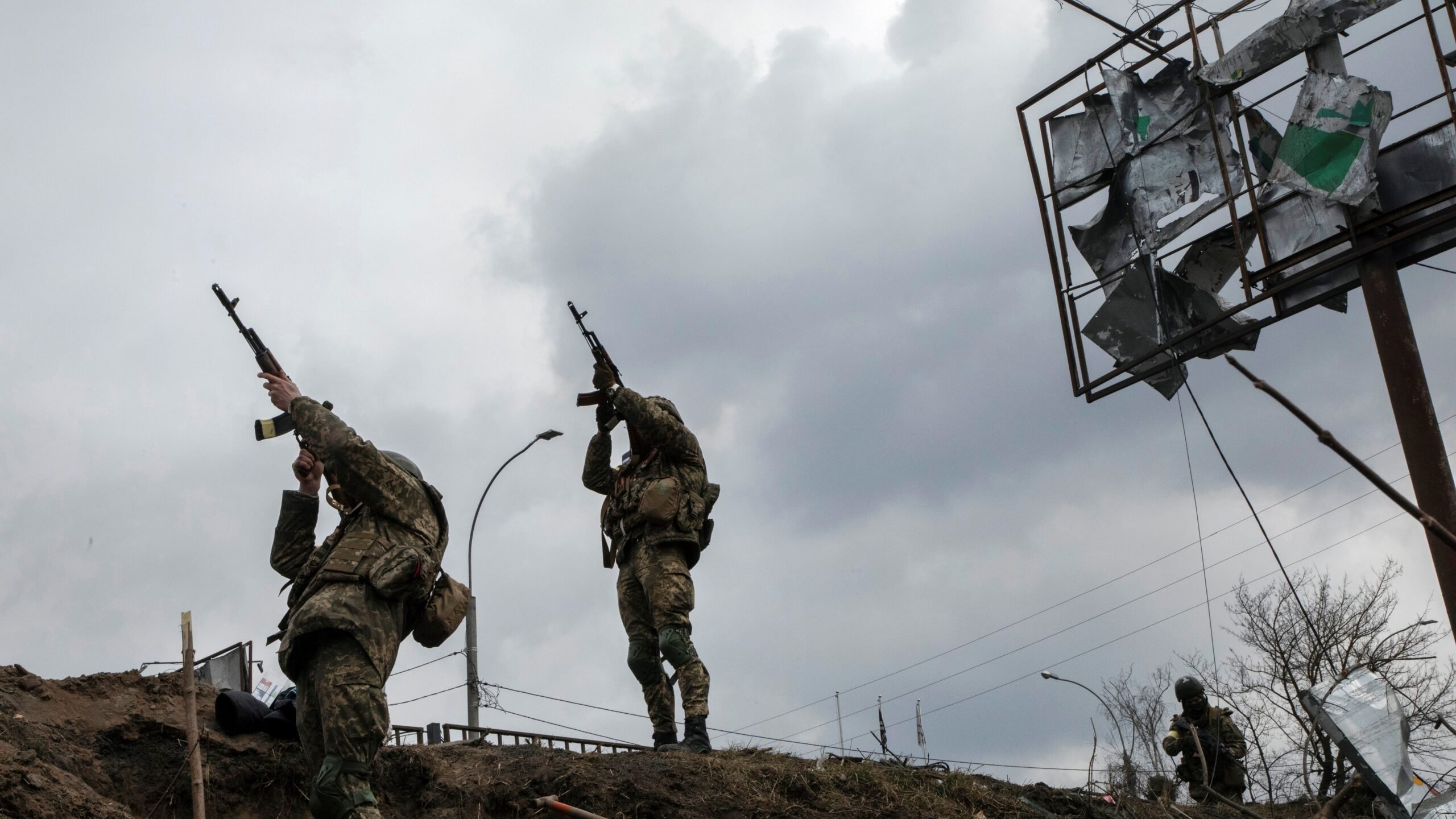
IRPIN,UKRAINE – MARCH 6: Ukrainian soldiers on the collapsed bridge that crosses the Irpin River aim for a suspected Russian observation drone on March 6, 2022 in Irpin, Ukraine. (Laurent Van der Stockt for Le Monde/Getty Images)
Edited 4/21/22 at 4:29 EST to include comments from Pentagon Press Secretary John Kirby, who walked back the department’s previous characterization of Phoenix Ghost.
WASHINGTON: The latest $800 million arms package for Ukraine includes a unique new item — the Phoenix Ghost tactical drone, a never-before revealed system designed by the US Air Force that will now prove its mettle on the battlefields of Ukraine.
The United States will provide more than 121 Phoenix Ghost Tactical Unmanned Aerial Systems, which are manufactured by AEVEX Aerospace, the Pentagon announced today.
Earlier today, a senior defense official said the new drone “was rapidly developed by the Air Force in response, specifically, to Ukrainian requirements.” However, in a later briefing, Pentagon Press Secretary John Kirby walked back that characterization, stating that the Phoenix Ghost was “developed before” Russia’s Feb. 24 invasion of Ukraine.
“It was developed for a set of requirements that very closely match what the Ukrainians need right now in Donbas,” he said.
The Phoenix Ghost is similar to the Switchblade unmanned systems previously delivered to Ukraine, the official said, in that it is a “one way drone” that is “clearly designed to give a punch” to a number of different types of targets. This likely means that Phoenix Ghost is a low-cost, single-use suicide drone that behaves like a loitering munition — flying around an airspace before ramming itself into a target.
That said, there are differences in the “scope of capability for the Phoenix Ghost, but I’m just not going to be able to get into more detail about those capabilities,” the official said, citing the classification of the new system.
RELATED: Top Pentagon acquisition nominee vows to expand production of munitions, drones
The official claimed to have “no idea” how Phoenix Ghost got its name, but noted that the new system would require minimal training for Ukrainian operators who are already familiar with Switchblade or other unmanned aircraft.
The Air Force declined to comment on the creation of Phoenix Ghost, directing all inquiries to the Pentagon.
AEVEX Aerospace’s role in the design and manufacturing of Phoenix Ghost is also murky, with the defense official providing few details.
Breaking Defense phoned the company’s Solana Beach, Calif.-based headquarters hoping to find out more information, but was told “We have no comment on the issue you are calling about” by the person who answered the phone. (Breaking Defense had identified itself as a member of the media but had not specifically inquired on Phoenix Ghost. Asked specifically about Phoenix Ghost, the representative for AEVEX repeated that she had no comment.)
AEVEX markets itself as a “a recognized leader in full-spectrum airborne intelligence solutions,” with experience in operating manned and unmanned intelligence aircraft, exploiting the data they collect, and fabricating drones or mission systems.
On March 4, AEVEX was one of more than 50 companies that received an indefinite-delivery/indefinite-quantity contract from the Navy to meet “new and emerging requirements” for areas including “combat integration and identification systems, ship and air integrated warfare systems, special communications mission solutions, air traffic control and landing systems, airborne systems integration, and integrated command and control and intelligence.” However it’s unclear whether this contract award has anything to do with the Phoenix Ghost.
The bespoke new drone is only one part of the latest $800 million arms package announced by President Joe Biden today. Also included are:
- 72 155mm Howitzers and 144,000 artillery rounds
- 72 Tactical Vehicles to tow 155mm Howitzers
- Field equipment and spare parts
The Biden administration has provided about $3.4 billion in security assistance for Ukraine since Russia’s invasion began on Feb. 24. The latest round of Howitzers, combined with an earlier package from April 13, “provides enough artillery systems to equip five battalions,” the Pentagon said in a statement.
Air Force picks Anduril, General Atomics for next round of CCA work
The two vendors emerged successful from an original pool of five and are expected to carry their drone designs through a prototyping phase that will build and test aircraft.


























